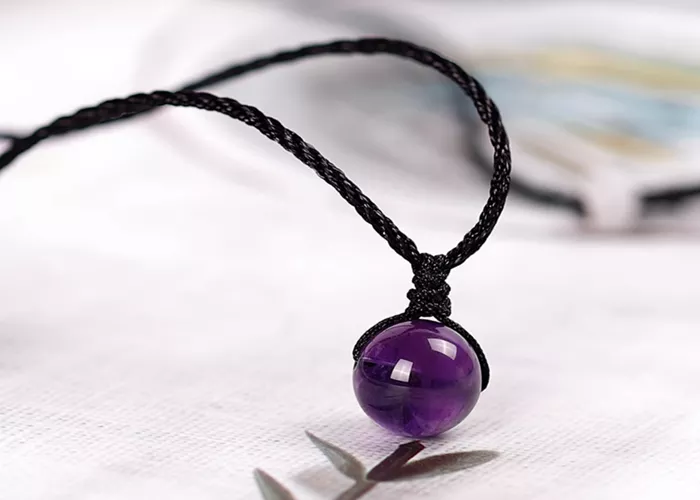Amethyst, a beautiful purple gemstone, is renowned for its vibrant color and spiritual properties. Often set in necklaces, rings, earrings, and bracelets, amethyst jewelry is popular among those who seek both beauty and healing. However, a common question arises when it comes to caring for amethyst jewelry: can you shower with an amethyst necklace? In this article, we will explore the potential risks of showering with your amethyst necklace, the factors that affect its durability, and the proper care techniques to keep it looking as stunning as the day you bought it.
The Durability of Amethyst Jewelry
Amethyst is a variety of quartz and, like other quartz gemstones, it has a relatively high hardness. It ranks 7 on the Mohs scale of hardness, which means it is durable enough to withstand normal wear and tear. However, despite its sturdiness, amethyst is not impervious to damage, especially when exposed to extreme conditions such as water, heat, or harsh chemicals.
Water Damage to Amethyst Jewelry
Water is generally not recommended for most types of jewelry, especially when the piece features porous or delicate gemstones. While amethyst itself is not highly porous, it can still be affected by prolonged exposure to water. In the case of an amethyst necklace, the metal setting and clasp may be more vulnerable to damage from moisture than the gemstone itself.
Metal Settings and Clasps
The metal used in the setting of your amethyst necklace plays a significant role in determining whether it is safe to shower with the jewelry. Gold, silver, and platinum are common metals used in jewelry, and each reacts differently to water. Gold is generally safe from corrosion, but constant exposure to water may cause it to tarnish or lose its luster over time. Silver, on the other hand, is more prone to tarnishing when exposed to moisture, especially if it’s not coated with a protective layer. Platinum is highly resistant to corrosion but may still dull if exposed to water repeatedly.
Chain and Clasp Issues
Amethyst necklaces often come with chains or clasps made from different metals such as sterling silver, gold, or stainless steel. While stainless steel is resistant to rust and corrosion, other metals like sterling silver can react with water, particularly if exposed to chlorine or saltwater. Over time, this can weaken the chain, causing it to break. Furthermore, the clasp mechanism may become more fragile with continuous water exposure, making it more likely to fail and lose your precious necklace.
Harsh Chemicals and Soap
When you shower, you typically use soap, shampoo, and other personal care products. These chemicals can have a negative impact on your amethyst necklace. Some soaps, for instance, contain oils that can build up on the surface of the amethyst, dulling its vibrant purple hue. Additionally, exposure to harsh chemicals such as bleach or cleaning agents can cause discoloration or even damage to both the gemstone and its setting. Prolonged exposure to chemicals may lead to scratches or degrade the clarity of the stone, making your amethyst necklace lose its shine.
Heat Exposure
Another factor to consider when wearing amethyst jewelry in the shower is heat. Showers typically expose your jewelry to steam, which can cause the amethyst to expand and contract. Over time, this can weaken the stone or cause it to crack. Excessive heat can also affect the integrity of the setting, especially if the metal used in the necklace is not heat-resistant. Prolonged exposure to high temperatures may also cause the color of the amethyst to fade or change.
The Risk of Cracks and Chips
Amethyst is a relatively tough gemstone, but it can still be vulnerable to physical damage. Exposure to hot water or chemicals can weaken the structure of the stone, making it more susceptible to cracks or chips. Amethyst is also known to be sensitive to sudden temperature changes. If you go from a hot shower to a cold room, the drastic temperature shift can cause the stone to crack.
Maintaining Your Amethyst Necklace
To keep your amethyst necklace looking its best, it’s crucial to follow proper care guidelines.
Here are some tips to ensure your amethyst jewelry remains in top condition:
Remove Jewelry Before Showering: It’s always best to remove your amethyst necklace before getting into the shower. This minimizes the risk of exposure to water, soap, shampoo, or harsh chemicals that can damage the gemstone and its setting.
Store Your Necklace Properly: When you’re not wearing your amethyst necklace, store it in a cool, dry place away from direct sunlight. Avoid storing it in damp areas such as bathrooms. You can also keep it in a soft pouch or jewelry box to prevent scratches and other physical damage.
Clean with Care: To clean your amethyst necklace, use a soft cloth to wipe away any dirt or oils. If you need to deep clean the necklace, use warm water and a mild soap solution. Avoid using harsh chemicals, ultrasonic cleaners, or steam cleaners, as these can cause damage to the gemstone.
Inspect Regularly: Regularly inspect your amethyst necklace for signs of damage, especially after it has been worn for long periods. Check the clasp, chain, and setting to ensure everything is secure. If you notice any cracks, chips, or loose stones, take the necklace to a professional jeweler for repairs.
Conclusion
In conclusion, while amethyst is a relatively durable gemstone, it is best not to shower with an amethyst necklace. Prolonged exposure to water, chemicals, heat, and physical stress can all lead to damage over time. By taking proper care of your amethyst jewelry and removing it before showering, you can ensure that your necklace remains beautiful and in excellent condition for years to come. Proper maintenance and safe storage are essential to preserving the quality and longevity of your amethyst necklace.
Related topics:
- Does Amethyst Help You Sleep? Exploring the Benefits
- Is Pink Amethyst Real Amethyst?
- Discover the Best Grade of Amethyst for Stunning Jewelry


